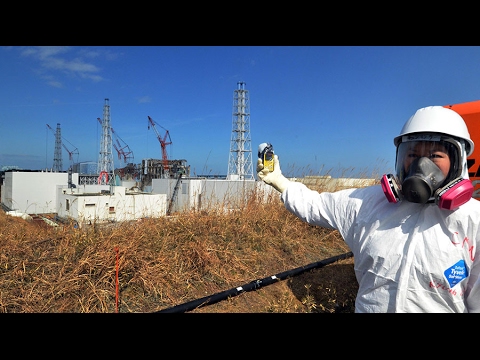Tokyo Electric Power (TEPCO) is reporting that the atmospheric readings inside Daiichi reactor Number 2 are as high as 530 Sieverts per hour.
A human exposed to a single dose of 10 Sieverts would die in a couple of weeks. The levels being recorded recently are 53 times that – per hour.
[I’ve been advised (although I haven’t seen this in any of the many latest posts about this development) that, “This high reading is because they have managed to enter a hotspot where a previous reading has not been possible. The actual background radiation is on the decline and the discovery of a hole is old news, as the leaks to date have to emanate from some fault in the pressure vessel.” I don’t think this minimizes the essential facts presented by Kevin Kamps on RT, below. Fukushima and its implications have been very underreported, considering the seriousness of the situation].Safely dismantling the plant has been an unfathomable challenge, made even more difficult by this discovery. The catastrophe at the Daiichi plant has been ongoing for nearly six years. The melted cores haven’t been found, Tokyo Electric doesn’t know where they are – nobody knows where they are.
Kevin Kamps from the nuclear watchdog group Beyond Nuclear speaks with RT America’s Simone del Rosario, saying, “There are many shoes that could still drop at Fukushima Daiichi. The high-level radioactive waste storage pools aren’t even inside radiological containment. They still don’t have all of the spent nuclear fuel transferred to a safer location in a couple of the units. So if something were to go wrong with that, those would be open air releases a very high-level radioactivity…
“There has been a contingency plan to evacuate all of Northeast Japan – up to 50 million people, mainly because of those storage pools. Meanwhile, Tokyo plans to host the 2020 Olympics and to bring in many millions of extra people into this densely-populated area.”
Japan is a world leader in robotics and has been using remote-controlled robots to assess the situation but these robots only have the capacity to withstand 1,000 Sieverts. The electronics get fried by the gamma- and likely neutron radiation that’s there.
In imagery obtained from robots, it appears that the cores have melted through the reactor pressure vessels and down into the containment structures, through that metal grating but it’s unconfirmed.
What is known is that there’s a daily flow of radioactive groundwater into the ocean of 80,000 gallons per day; relatively low-level radioactive waste water. In addition, there are 800,000 tons of highly radioactive water being stored in tanks, as every day, as they pour a hundred tons of water on each of these three melted down cores, which sometimes leak and overflow.
The situation is incredibly dire. There are figures of $150B dollars to decommission the plant. However, Greenpeace Japan has estimated a cost of up to $600B, if you do full cost accounting, of where is this high-level radioactive waste is going to go. It’s going to require a deep geologic repository, which will need to be built and operated, that costs $100B or more. This catastrophe could cost hundreds of billions of dollars over 40 years and this is just at the beginning, when we’re dealing with massive amounts of accumulating waste with radioactive half lives in the tens of thousands of years.
It’s an unprecedented catastrophe for the world’s oceans and six years later, the situation is far from being under control.

